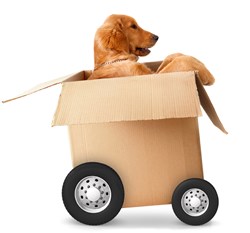
Relocating, no matter the distance, is stressful for everyone, including your pets.
“How to safely move pets is a question we are asked over and over again,” says Jerry Funaro, vice president of global marketing for TRC Global Mobility, Inc., a global mobility firm based in Milwaukee, Wis. “Pets are members of the family, and their safety and health is a critical part of a successful relocation.”
According to the Humane Society of the United States, pets are sensitive by nature: If you’re stressed, so are they. Relocating pets from the safe confines of your home takes understanding, care and an investment of time that starts long before moving day.
TRC has developed a 15-point checklist to make a pet’s transition to a new home seamless and less stressful. (If you’re planning to move a pet to another country, remember that rules and regulations vary widely from country to country. Some countries impose quarantine requirements and some make it very difficult or impossible to bring in specific breeds or pets in general. It’s important to research the host country’s requirements well in advance.)
Before the move:
- If your pet will be crated for the move, buy the crate as soon as you know you are moving, and then gradually acclimate your pet to the crate. You can start by placing food inside the crate’s open door. The next step would be to close the crate’s door and let him eat inside. And carry your pet around in the crate to get him used to movement.
- If possible pack gradually, so your pet will get accustomed to change. Choose one room in your house with a door, and fill it with items your pet loves. On moving day, keep your pet in this room, and stop by from time to time to give your pet a friendly pat. This should be the last room the movers pack up. Alternately, you could put your pet in his crate in a secluded area of the backyard, free from the clutter and noise. But again, visit often to let your pet know you are around. Or, you could board your pet while the move is taking place.
- Moving week, have your pet groomed. Funaro recalls one transferee who scheduled a day of grooming for the family dog on moving day. “It was the perfect solution,” he says. “The dog missed all the chaos of moving day, and when the family picked him up, he was sweet-smelling, his nails were clipped, and he was ready for the trip.”
- Update your pet’s tag with your name, new address and your cell phone number, important information in case of an emergency.
- Ask your veterinarian for your pet’s records. If you have already contacted a new vet, have the pet’s records sent directly to that office. Depending on your destination, your pet may need additional vaccinations, medications or health certificates.
- If your pet takes daily medication or eats specific foods, bring along an extra supply. In addition, get written prescriptions for any medications that can be filled at your destination.
- Pack a bag for your animal, filled with food, toys and a gallon of water.
- Not all pets are furry. For example, fish and reptiles pose their own set of moving concerns. If you are not making the move in one day, professional animal moving firms offer overnight shipping.On the road:
- In the car, your pets should be in their crates, or at the very least, a restraining device.
- If traveling by air, check the airline requirements so you can take the steps needed to keep your pet safe. Some airlines allow pets in the cabin, depending on the animal’s size. Your vet knows your pet, and can offer suggestions on how to make the trip less stressful, including sedatives to keep the pet calm.
- If you are sedating your pet, keep a log of each dose. Moving day can be stressful, and trying to remember when you gave your pet his last dose of medicine will add to the hassle.
- Not all moves are done in one day. If you are on the road, call pet-friendly hotels along your route and verify individual pet policies. Many pet-friendly hotels have limited rooms available, so it’s wise to make reservations in advance.
At your destination:
- A new home might overwhelm your pet, so introduce him gradually to his new surroundings. Place the pet’s bed or litter box in one room – preferably one that is similar to the one in your old home – include some toys, and let the pet get comfortable there. Then gradually begin to introduce your pet to the rest of the home, room by room. This will also stop your pet from escaping through doors and windows left open by the movers.
- Keep your pet’s activities constant. If they eat twice a day, be sure to follow this on the trip to your new home and in the new environs. Same with walks.
- Carefully inspect your new yard to be sure gates are closed, and that there are no chemicals or harmful articles present. Keep outdoor cats indoors for a few nights until they get used to their new surroundings. Gradually let them spend more time outside.
About TRC Global Mobility
TRC Global Mobility is the only 100% employee-owned relocation management company. Since 1987, we’ve worked to create the most successful relocation experience possible for our clients and their relocating employees. Not only do we have a direct financial stake in the success of our company, we also have ownership over client happiness. Everyone is motivated to do their best work. Everyone takes pride in client satisfaction. TRC’s diverse client base represents a wide variety of products and services and ranges from smaller, start-up firms to Global 1000 companies.




